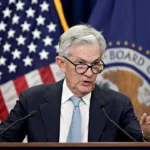오늘 PU Xtrader 챌린지에 참여하세요
시뮬레이션 자본으로 거래하고 우리의 트레이더 평가를 통과한 후 실제 이익을 얻으십시오.
오늘 PU Xtrader 챌린지에 참여하세요
시뮬레이션 자본으로 거래하고 우리의 트레이더 평가를 통과한 후 실제 이익을 얻으십시오.
On Wednesday, 6 April (GMT+3), the Federal Open Market Committee (FOMC) released the minutes for its 15-16 March meeting. As expected, the meeting was focused on discussing the tightening measures that the Fed would take to rein in galloping inflation. Chiefly, the central bank has plans to shrink its almost-US$9 trillion balance sheet at a maximum rate of $95 billion a month, with $60 billion coming from treasuries, and $35 billion coming from mortgage-backed securities.
In addition to shrinking its balance sheet, the minutes also stated that “many” Fed officials have noted that, while a 50-point increase at the meeting would have been preferred, in light of the uncertainty caused by the Russia-Ukraine conflict, the finalised 25-point hike was “appropriate”. However, “50 basis point increases in the target range could be appropriate at future meetings”, especially if the high inflation does not subside.
Post-Market
Despite 40-year high inflation numbers, gold’s attractiveness as an inflation hedge has become tepid amid rising bond yields and Fed hawkishness, since rising interest rates increase the opportunity cost of holding non-yielding gold.
Earlier on Wednesday, gold prices dipped 1.2% to $1,894.70 after Treasury yields jumped. However, the price of the precious metal has since stabilised near $1925. In a quote given to CNBC, Tai Wong, an independent metals trader in New York, has said that he expects “gold prices to trade between $1,880-$1,960 range in the near-term.
Meanwhile, news of the Fed’s aggressive stance against inflation has sent US equities tumbling and the dollar soaring, with the US Dollar Index, which measures the dollar against a basket of major currencies, hitting its highest point — 99.778 — since May 2020. This has been supported by rising Treasury bond yields, with the 10-year note hitting a high of 2.656%.
In addition, uncertainty surrounding the conflict in Eastern Europe and increasing sanctions on Russia continues to weaken commodity-linked currencies as well as the euro. European leaders have been unable to reach a conclusion on sanctioning Russian coal, with European Commission President Ursula von der Leyen saying that any new sanctions against the Kremlin would not be the last.
Eyes are now on monetary policy in the Eurozone, and investors are advised to pay close attention to the upcoming minutes of the European Central Bank meeting, which will be released on 7 April, 14:30 (GMT+3). As a friendly reminder, do keep an eye on market changes, control your positions, and manage your risk well.

Trade forex, indices, cryptocurrencies, and more at industry-low spreads and lightning-fast execution.

8 December 2023, 01:37 Economists Anticipate The Fed To Keep Rates Steady In December

4 December 2023, 03:20 Nonfarm Payrolls Forecasted At 175K Increase

24 November 2023, 02:43 Anticipation Of RBNZ Holding High Rates

새로운 등록 불가능
현재 새로운 등록을 받고 있지 않습니다.
새로운 가입은 사용할 수 없지만, 기존 사용자는 평소와 같이 도전과 거래 활동을 계속할 수 있습니다.